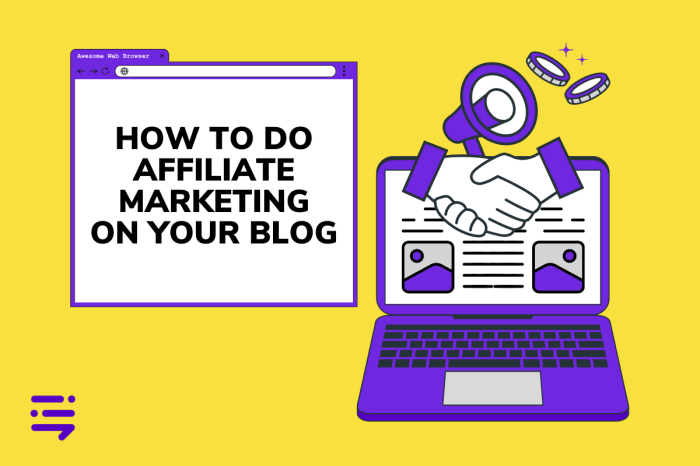
Step into the world of for affiliate marketing, where your website’s potential for success is limitless. Let’s dive into the strategies that can elevate your affiliate marketing efforts to new heights!
Get ready to explore how can make a significant impact on the performance of affiliate marketing websites and unlock new opportunities for growth and success.
for Affiliate Marketing
In the world of affiliate marketing, Search Engine Optimization () plays a crucial role in driving traffic to affiliate websites and increasing conversions. By optimizing your website for search engines, you can improve your visibility, attract more visitors, and ultimately boost your affiliate marketing efforts.
Importance of in Affiliate Marketing
is essential in affiliate marketing as it helps affiliate marketers rank higher in search engine results pages (SERPs), making it easier for potential customers to find their websites. By targeting relevant s and optimizing content, affiliates can attract organic traffic and increase their chances of earning commissions.
- Optimizing website content with relevant s can improve search engine rankings and increase visibility.
- Creating high-quality content that resonates with the target audience can drive more traffic to affiliate websites.
- Building backlinks from reputable sites can enhance the credibility and authority of affiliate websites.
Common Strategies in Affiliate Marketing
Affiliate marketers use a variety of strategies to improve their rankings and drive organic traffic to their websites. Some common strategies include:
- research and optimization to target relevant search terms.
- Creating high-quality, engaging content that provides value to readers.
- Optimizing meta tags, headings, and URLs for better visibility in search results.
- Building a strong backlink profile through guest posting, outreach, and partnerships.
Tips for Optimizing for Affiliate Marketing Websites
To optimize specifically for affiliate marketing websites, consider the following tips:
- Focus on creating valuable content that addresses the needs and interests of your target audience.
- Use relevant s strategically throughout your content, including in titles, headings, and meta tags.
- Optimize your website for mobile devices to improve user experience and search engine rankings.
- Monitor your website’s performance using analytics tools and make adjustments to improve over time.
Marketing E-commerce
Marketing plays a crucial role in the e-commerce industry, where businesses need to attract, engage, and retain customers in the online marketplace. Traditional marketing methods have evolved significantly with the rise of e-commerce, leading to the adoption of modern techniques that leverage digital platforms and data analytics to drive sales and brand awareness.
Role of Marketing in E-commerce
Marketing in e-commerce involves creating strategies to promote products or services online, reach target audiences, and drive conversions. This includes activities such as search engine optimization (), social media marketing, email campaigns, and influencer partnerships. The goal is to enhance the online shopping experience, build brand loyalty, and increase revenue.
Comparison of Traditional vs. Modern E-commerce Marketing
- Traditional marketing relies on print ads, TV commercials, and direct mail, while e-commerce marketing focuses on digital channels like social media, search engines, and email.
- Modern e-commerce marketing allows for precise targeting, real-time analytics, and personalized messaging, unlike traditional methods that have limited measurability and reach.
Key Challenges in E-commerce Marketing
- Competition: E-commerce businesses face intense competition online, requiring them to differentiate their offerings and stand out in a crowded marketplace.
- Customer Trust: Building trust and credibility with online shoppers is essential to drive sales and repeat business.
- Adapting to Trends: E-commerce marketers must stay updated on digital marketing trends and technology advancements to remain competitive.
Impact of Digital Marketing Trends on E-commerce Businesses
- Personalization: Tailoring marketing content based on customer preferences and behavior leads to higher engagement and conversions.
- Mobile Optimization: With the increasing use of smartphones for online shopping, optimizing websites and ads for mobile devices is crucial for e-commerce success.
- AI and Automation: Implementing artificial intelligence and automation tools can streamline marketing processes, improve targeting, and enhance customer experiences.
Advertising

Advertising plays a crucial role in promoting products or services by reaching out to a target audience and creating brand awareness. It helps businesses communicate their unique selling points, offers, and benefits to potential customers, ultimately driving sales and revenue.
Significance of Advertising
Effective advertising campaigns are essential for businesses to stand out in a competitive market. They help build brand recognition, establish credibility, and influence consumer behavior. By strategically placing advertisements across various channels, companies can reach a wider audience and generate leads that can convert into loyal customers.
Examples of Effective Advertising Campaigns
- Coca-Cola’s “Share a Coke” campaign personalized their product by putting people’s names on the bottles, creating a buzz and increasing sales.
- Nike’s “Just Do It” campaign inspired consumers to push their limits and associate the brand with motivation and success.
- Apple’s “Get a Mac” ads featuring contrasting characters highlighted the benefits of their products over competitors, increasing market share.
Evolution of Advertising
Advertising has evolved from traditional mediums like print, radio, and TV to digital platforms such as social media, search engines, and influencer marketing. Digital advertising allows for more targeted and personalized campaigns, real-time analytics, and interactive content that engages consumers on a deeper level.
Tips for Creating Compelling Advertisements
- Understand your target audience and tailor your message to resonate with their needs and preferences.
- Use eye-catching visuals, compelling storytelling, and a clear call-to-action to capture attention and drive conversion.
- Test different ad formats, messaging, and placements to optimize performance and maximize ROI.
- Leverage data analytics to track the effectiveness of your campaigns and make data-driven decisions for future advertising strategies.
Affiliate Marketing
Affiliate marketing is a performance-based marketing strategy where businesses reward affiliates for driving traffic or sales to their website through the affiliate’s marketing efforts. Affiliates earn a commission for each sale or lead generated through their unique affiliate link.
Benefits of Affiliate Marketing
- Affordable Marketing: Businesses only pay for actual results, making it a cost-effective marketing strategy.
- Increased Reach: Affiliates help businesses reach new audiences that they may not have been able to target on their own.
- Enhanced Credibility: Affiliates act as trusted sources, providing authentic recommendations to their audience.
- Performance-Based: Businesses can easily track the performance of their affiliate marketing campaigns and adjust strategies accordingly.
Key Strategies for Successful Affiliate Marketing Partnerships
- Choose the Right Affiliates: Select affiliates whose audience aligns with your target market for better results.
- Provide Quality Resources: Equip affiliates with the necessary tools, resources, and support to promote your products effectively.
- Transparent Communication: Maintain open communication with affiliates to ensure mutual understanding and collaboration.
- Incentivize Performance: Offer attractive commissions or bonuses to motivate affiliates to drive more sales and leads.
Future Trends of Affiliate Marketing in the Digital Landscape
- Rise of Influencer Marketing: Collaboration with influencers to promote products through affiliate links will continue to grow.
- Mobile Optimization: With the increasing use of smartphones, optimizing affiliate marketing strategies for mobile devices will be crucial.
- AI and Data Analytics: Leveraging AI and data analytics to personalize affiliate marketing campaigns for better targeting and results.
- Video Content Dominance: Incorporating video content into affiliate marketing strategies to engage audiences and drive conversions.
Branding
Branding is the process of creating a unique identity for a product or service in the minds of consumers. It involves establishing a consistent image, message, and reputation that sets a business apart from its competitors. Effective branding can help build trust, loyalty, and recognition among customers, ultimately leading to increased sales and market share.
Importance of Branding
Branding is crucial in marketing because it helps differentiate a business from its competitors and creates a lasting impression on consumers. A strong brand can foster customer loyalty, increase brand awareness, and drive customer engagement. It also helps businesses establish credibility, build trust, and command premium pricing.
- Apple’s branding strategy focuses on simplicity, innovation, and sleek design, which has helped the company build a loyal customer base and stand out in the competitive tech industry.
- Coca-Cola’s iconic red and white logo, along with its memorable advertising campaigns, have made it one of the most recognized and valuable brands in the world.
- Nike’s “Just Do It” slogan and endorsement deals with top athletes have solidified its position as a leading sports apparel brand with a strong emotional connection to its customers.
Impact of Branding on Consumer Perception and Loyalty
Branding plays a significant role in shaping how consumers perceive a business and its products. A strong brand can evoke positive emotions, build trust, and create a sense of identity and community among customers. It can also influence purchasing decisions, as consumers are more likely to choose brands they trust and feel connected to.
- Consistent branding across all touchpoints, including packaging, advertising, and customer service, helps reinforce a brand’s message and values, leading to a more cohesive brand experience for consumers.
- Brand loyalty is built over time through positive interactions, quality products, and memorable experiences that align with the brand’s identity and values.
- Brands that deliver on their promises and consistently meet customer expectations are more likely to earn repeat business and referrals, creating a loyal customer base that can drive long-term success.
Tips for Developing a Strong Brand Identity for E-commerce Businesses
Developing a strong brand identity is essential for e-commerce businesses looking to stand out in a crowded marketplace and build lasting relationships with customers. Here are some tips to help you create a compelling brand presence online:
- Define your brand values, mission, and personality to establish a clear identity and voice that resonates with your target audience.
- Create a visually appealing and cohesive brand aesthetic, including a logo, color palette, and typography, that reflects your brand’s values and communicates your message effectively.
- Consistently communicate your brand story and key messaging across all marketing channels, from your website and social media to email campaigns and advertising.
- Engage with your audience authentically and build relationships by responding to feedback, addressing customer concerns, and showcasing your brand’s unique personality and values.
- Monitor and analyze your brand’s performance, including customer feedback, social media mentions, and sales data, to track your brand’s growth and make informed decisions to strengthen your brand identity over time.
Direct Marketing
Direct marketing is a strategy used by businesses to communicate directly with targeted customers in order to promote products or services. This approach allows for personalized messaging and a more direct connection with the audience, leading to higher engagement and conversion rates.
Principles of Direct Marketing
Direct marketing is based on the principles of targeting specific customer segments, personalized communication, measurable results, and building long-term relationships with customers. By understanding the needs and preferences of individual customers, businesses can tailor their marketing messages to resonate with each recipient.
- Segmentation: Divide the target audience into specific segments based on demographics, behavior, or preferences to create personalized campaigns.
- Personalization: Customize marketing messages and offers to meet the individual needs and interests of each customer.
- Measurement: Use key metrics such as response rates, conversion rates, and ROI to evaluate the effectiveness of direct marketing campaigns.
- Relationship Building: Focus on building strong relationships with customers through regular communication and personalized interactions.
Comparison with Other Advertising Methods
Direct marketing differs from traditional advertising methods like TV commercials or print ads in that it allows for more targeted and personalized communication. While mass advertising can reach a wide audience, direct marketing focuses on reaching specific individuals who are more likely to be interested in the product or service being offered.
- Targeting: Direct marketing targets specific customer segments, while traditional advertising reaches a broader audience.
- Personalization: Direct marketing offers personalized messages, whereas traditional advertising uses one-size-fits-all approaches.
- Measurability: Direct marketing campaigns can be easily tracked and measured, providing insights into the effectiveness of the strategies used.
- Engagement: Direct marketing allows for more direct interaction with customers, leading to higher engagement levels compared to traditional advertising.
Key Metrics for Success
When measuring the success of direct marketing campaigns, businesses should consider key metrics such as response rates, conversion rates, ROI, customer acquisition costs, and customer lifetime value. These metrics help evaluate the effectiveness of the campaign and identify areas for improvement.
- Response Rates: Measure the percentage of recipients who respond to the marketing message or call to action.
- Conversion Rates: Track the number of recipients who take the desired action, such as making a purchase or signing up for a service.
- ROI: Calculate the return on investment to determine the profitability of the direct marketing campaign.
- Customer Acquisition Costs: Evaluate the cost of acquiring new customers through direct marketing efforts.
- Customer Lifetime Value: Determine the long-term value of each customer to the business, considering repeat purchases and loyalty.
Best Practices in E-commerce
Implementing direct marketing strategies in e-commerce requires businesses to focus on creating personalized experiences, optimizing customer data, leveraging automation tools, and continuously testing and refining their campaigns. By following best practices, businesses can improve customer engagement and drive conversions in the competitive e-commerce landscape.
- Personalized Experiences: Use customer data to create personalized messages and offers that resonate with individual recipients.
- Optimizing Customer Data: Collect and analyze customer data to gain insights into preferences, behaviors, and purchasing patterns.
- Leveraging Automation: Implement marketing automation tools to streamline campaigns, deliver targeted messages, and track performance efficiently.
- Continuous Testing: A/B test different elements of direct marketing campaigns to identify what resonates best with the target audience and optimize for better results.
Internet Marketing
Internet marketing encompasses a wide range of strategies and channels used to promote products or services online. It plays a crucial role in reaching and engaging with target audiences in the digital space.
Various Channels and Strategies in Internet Marketing
- (Search Engine Optimization): Optimizing websites to rank higher in search engine results pages, increasing visibility and organic traffic.
- Social Media Marketing: Leveraging social media platforms to connect with audiences, build brand awareness, and drive website traffic.
- Email Marketing: Sending targeted emails to leads and customers to nurture relationships, promote products, and drive conversions.
- Content Marketing: Creating and distributing valuable content to attract and engage audiences, establish thought leadership, and drive conversions.
Examples of Successful Internet Marketing Campaigns
- Red Bull’s Stratos Jump: Red Bull’s live-streamed space jump by Felix Baumgartner generated massive social media buzz and brand awareness.
- Old Spice’s “The Man Your Man Could Smell Like” Campaign: A viral video series featuring the Old Spice Guy led to increased brand engagement and sales.
Maximizing ROI through Internet Marketing Efforts
- Set Clear Goals: Define specific and measurable objectives for each internet marketing campaign to track performance and ROI.
- Monitor Analytics: Regularly analyze website traffic, social media engagement, email open rates, and other metrics to optimize campaigns for better results.
- Segment Audiences: Tailor marketing messages and content to different audience segments to increase relevance and engagement.
- Test and Iterate: Experiment with different strategies, creatives, and messaging to identify what resonates best with your target audience and refine your approach accordingly.
Mailing Lists
Building and nurturing a mailing list is a crucial aspect of any digital marketing campaign. By collecting email addresses from interested individuals, businesses can directly reach out to their target audience to promote products, services, or special offers. Here are some key points to consider when it comes to mailing lists:
Significance of Mailing Lists
- Direct Communication: Mailing lists allow businesses to communicate directly with their audience without relying on social media algorithms or search engine rankings.
- Personalized Messaging: With email marketing, businesses can personalize messages based on subscriber preferences, behavior, or demographics.
- Conversion Opportunities: Email campaigns can drive conversions by directing subscribers to specific landing pages, promotions, or products.
Benefits of Building and Nurturing an Email Subscriber List
- Targeted Marketing: Mailing lists enable businesses to target specific segments of their audience with relevant content.
- Customer Loyalty: By regularly engaging with subscribers through email, businesses can build relationships and foster customer loyalty.
- Cost-Effective: Compared to traditional marketing channels, email marketing is a cost-effective way to reach a large audience.
Tools and Techniques for Managing and Segmenting Mailing Lists
- Email Marketing Platforms: Utilize platforms like Mailchimp, Constant Contact, or ConvertKit to manage and automate email campaigns.
- Segmentation: Divide your mailing list into different segments based on demographics, behavior, or interests to send targeted messages.
- A/B Testing: Test different subject lines, content, or send times to optimize email performance and engagement.
Tips for Creating Engaging Email Content
- Compelling Subject Lines: Use catchy subject lines to grab the subscriber’s attention and encourage them to open the email.
- Visual Content: Incorporate images, videos, or infographics to make your emails visually appealing and engaging.
- Call-to-Action: Include clear call-to-action buttons to prompt subscribers to click through to your website or landing page.
Last Point

As we wrap up our discussion on for affiliate marketing, remember to implement these strategies to see a positive change in your website’s performance. Elevate your affiliate marketing game with the power of !
User Queries
How important is in affiliate marketing?
plays a crucial role in driving organic traffic to affiliate marketing websites, increasing visibility and potential for conversions.
What are some common strategies used in affiliate marketing?
Some common strategies include optimization, link building, content marketing, and website optimization for better search engine rankings.
How can benefit affiliate marketing efforts?
can help affiliate marketers reach a wider audience, improve brand visibility, and increase the chances of attracting potential customers.





